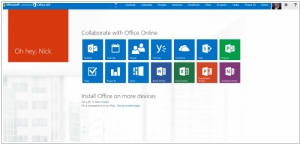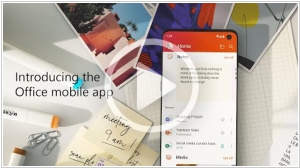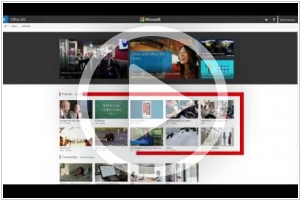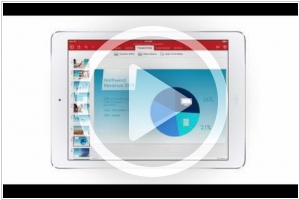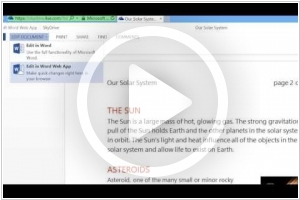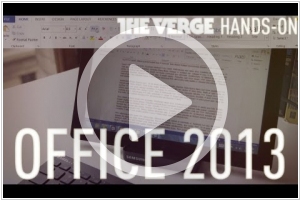Microsoft 365 is #1 in Top 10 Office suites
Microsoft 365 (formerly Microsoft Office 365) is commercial software plus services offering a set of products from Microsoft. Designed to help you achieve more with innovative Office apps, intelligent cloud services, and world-class security. The free online MS Office document editors (Word, Excel, PowerPoint) are available in OneDrive.
Positions in ratings
#1 in Top 10 Office suites
Alternatives
The best alternatives to Microsoft 365 are: Google Workspace, Zoho, OneDrive, LibreOffice, iWork
See also:
Top 10 Office suites
Top 10 Office suites
Latest news about Microsoft 365
2022. Microsoft Office is getting a new name - Microsoft 365
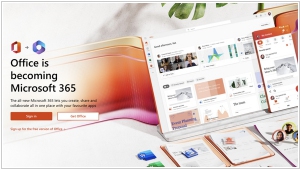
Microsoft 365 is the new name chosen by Microsoft to rebrand its 32-year-old software package. Over the next few months, Office.com, the Office mobile app, and the Office app for Windows will undergo a transformation and become the Microsoft 365 app, featuring a fresh icon, an updated appearance, and an expanded set of features. However, the names of the individual apps within the Microsoft Offi... I mean, the Microsoft 365 software suite, such as Word, Excel, PowerPoint, Outlook, Teams, OneDrive, and others, will remain unchanged. Rest assured, Office itself will not disappear immediately. Microsoft has confirmed that it will continue to offer one-time purchases of individual Office apps through Office 2021 and Office LTSC plans, and there will be no alterations to Office 365 subscription plans.
2022. Microsoft may discontinue selling software and services to Russia

The U.S. Department of Commerce's Bureau of Industry and Security (BIS) has recently implemented new export control regulations concerning Russia, imposing limitations on the export of hardware and software to the country. There have been calls for Microsoft to refrain from exporting software to Russia, although the company has yet to provide any official response. Uncertainty remains regarding the differentiation between software usage for consumer and industrial purposes, as well as how U.S. companies will navigate these sanctions. The potential consequences of this ban are significant, as it could impede Russia's long-term economic growth by preventing companies from upgrading their Windows and Office software. In recent years, the Russian government has attempted to reduce reliance on Microsoft within the country, but achieved limited success.
2020. Microsoft brings transcriptions to Word
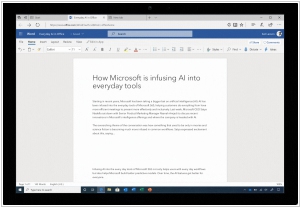
Microsoft launched Transcribe in Word, its new transcription service for Microsoft 365 subscribers. The service is currently available in the online version of Word, with plans to expand to other platforms in the future. Additionally, Word is introducing new dictation features that allow users to format and edit their text using their voice. This feature enables users to transcribe both live and pre-recorded speech and make edits directly within Word. By offering these capabilities, Microsoft enters the competition against startups like Otter and Google's Recorder app, each with their own strengths and weaknesses. Currently, Transcribe in Word is limited to English and only accessible to paid Microsoft 365 accounts.
2020. Microsoft rebrands Office 365 to Microsoft 365
Microsoft marketers seemingly found themselves with spare time during the quarantine and decided to rebrand Office 365 as Microsoft 365. Effective from April 21, all Office subscriptions will be transitioned to Microsoft 365 subscriptions. However, the pricing and functionality will remain unchanged. The alterations to functionality will only impact personal plans, where the personal version of Microsoft Teams will be introduced. This presents a valuable opportunity for individual entrepreneurs utilizing the personal version to collaborate with employees or other entrepreneurs. In the future, Microsoft intends to justify the rebranding by incorporating non-Office services, including security systems, and potentially even integrating the Windows operating system.
2020. Microsoft launches unified Office app for iOS and Android
Microsoft has made a significant announcement regarding its Dynamics 365 product line, in response to the growing volume of enterprise data and the need to collect and analyze it effectively to enhance customer experiences. The company is introducing new features to its customer data platform (CDP), a concept that has gained traction among major vendors and a growing number of startups. The CDP consolidates customer data from various systems into a single location, simplifying the understanding of customer interactions. The ultimate objective is to leverage this knowledge to deliver enhanced customer experiences. Microsoft's CDP is known as Customer Insights. It is important to note that Microsoft is not the only player in this domain. Other prominent companies like Adobe, Salesforce, and SAP offer similar products for similar reasons, as part of their marketing toolsets.
2019. Microsoft merges mobile Word, Excel and PowerPoint into single Office app
Microsoft has unveiled the Office app, a revolutionary solution that delivers a streamlined and integrated experience by merging the existing Word, Excel, and PowerPoint mobile applications. This groundbreaking development consolidates all your Office documents into a unified platform, eliminating the need to switch between multiple apps and significantly reducing the storage footprint on your phone compared to individual installations. With the new app, you gain convenient access to recent and recommended documents stored in the cloud or on your device. If you have a work account, you can even search for documents across your organization. Additionally, the app empowers you to capture a photo of a document and effortlessly convert it into an editable Word file with a single tap. It also enables you to transform images of tables into functional Excel spreadsheets, allowing seamless data manipulation. Moreover, integrated Office Lens features within the app enable you to create enhanced digital copies of whiteboards and documents, making collaboration and archiving more efficient.
2019. Microsoft added table OCR to mobile Excel
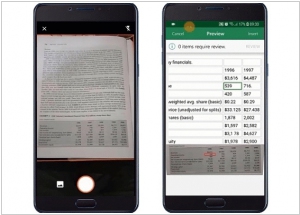
Microsoft has introduced a new functionality to the mobile Excel application, enabling users to capture an image of a printed table and convert it into an editable Excel spreadsheet. Currently, this feature is exclusively available for Android users, but it will soon be extended to iOS as well. It is important to note that this feature is limited to Office 365 users. However, it is primarily designed for simple tables, as more complex tables with merged cells may result in recognition errors.
2018. Microsoft launches Office 2019 for Windows, macOS
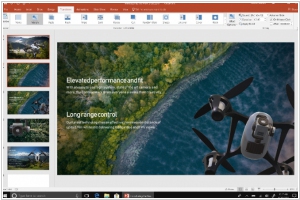
Office 2019 represents the latest version of Microsoft's suite of productivity tools, including Word, Excel, PowerPoint, Outlook, Project, Visio, Access, and Publisher, available for on-premises use. With PowerPoint 2019, users can create captivating presentations using new features such as Morph and Zoom, enabling cinematic effects. Across Windows applications, including the roaming pencil case, pressure sensitivity, and tilt effects, enhanced inking features provide a natural way to create documents. Excel 2019 introduces powerful data analysis capabilities, encompassing new formulas, charts, and enhancements to PowerPivot. Word 2019 and Outlook 2019 are designed to enhance productivity and focus. Learning Tools, such as Read Aloud and Text Spacing, facilitate content engagement, while Focus Mode eliminates distractions and prioritizes content visibility. Additionally, Focused Inbox streamlines email management by filtering less important messages.
2018. Microsoft removes device limits for consumer Office 365 subscribers
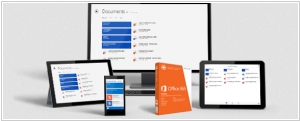
Microsoft has announced that it will soon eliminate the device limit on its consumer-grade Office 365 subscriptions and increase the number of users allowed within a single Office 365 Home plan. Effective from October 2, subscribers will be able to install Office on an unlimited number of devices. Presently, Office 365 Home, priced at $100 per year, permits installation of the suite's applications (such as Word, Outlook, Excel, etc.) on only 10 devices, or two devices per user for up to five users covered by a single subscription. On the other hand, Office 365 Personal, a $70 annual plan catering to individual users, currently limits the device count to a total of two.
2018. Microsoft Office gets the new-old design
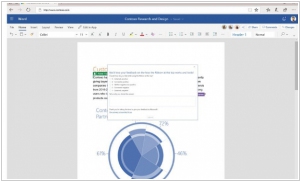
Microsoft has commenced the gradual implementation of subtle design changes to Office.com and Office 365, aiming to create a more streamlined and uncluttered appearance. The most significant modification will be applied to Microsoft Word, specifically targeting the toolbar located at the top of the screen, commonly known as "the ribbon." In its new iteration, the ribbon will be condensed to a single line, simplifying the interface. However, users who prefer the classic design can expand it back to its larger form if desired. These updates align with Microsoft's overarching design language, Fluent Design, which is prevalent across various aspects of Windows 10. Alongside the streamlined ribbon, users can expect new animations, icons, and minor color adjustments. Microsoft has decided to delay the implementation of the simplified ribbon for desktop users by a few months, as they are currently testing the new designs in the online applications. Feedback from users will be carefully considered to determine if any further modifications are necessary for the desktop versions.
2017. Microsoft Office arrived on Chromebooks

Full-featured versions of Microsoft Office apps can now be found on the Google Play Store for Chromebooks. However, if you wish to utilize Office apps on devices with screens larger than 10.1 inches, beyond mere document viewing, you will require a Microsoft Office 365 subscription, which starts at $6.99 per month. Additionally, you must possess one of the latest Chromebooks, as Chrome OS only gained the capability to support Android applications last year. While many Chromebook users still prefer Google's G Suite, the availability of Microsoft Office on Chromebooks enhances their potential suitability for businesses relying on Microsoft software. Another alternative is Windows 10 S, a streamlined version of Windows 10 positioned as a competitor to Chrome OS by the company.
2017. Microsoft adds 5 new services for SMB to Office 365 Business Premium
In order to further integrate small businesses into the Office 365 ecosystem, Microsoft has recently launched (in preview) five new tools specifically designed for SMBs. One of these tools, Microsoft Connections, enables users to create email marketing campaigns similar to Mailchimp. Another tool, Microsoft Listings, facilitates the management of business listings on popular platforms such as Facebook, Google, Bing, and Yelp, while also providing the ability to monitor online views and reviews. Additionally, Microsoft Invoicing allows for the rapid creation of professional-looking estimates and invoices, ensuring prompt payment processing. These new tools will be consolidated within the Office 365 Business Center, alongside the previously introduced Microsoft Bookings and Outlook Customer Manager. Furthermore, the Office 365 Business Premium package will also include the app MileIQ, which helps track business mileage when using personal vehicles. Over the next few weeks, these new services will be available for preview to Office 365 Business Premium subscribers in the United States, United Kingdom, and Canada.
2017. Microsoft launched StaffHub - a new Office 365 app aimed at shift workers
Microsoft has introduced a new application called StaffHub as part of its Office 365 suite. Designed specifically for shift workers and management, StaffHub caters to individuals in various industries such as retail, hospitality, and restaurants, who have flexible schedules that vary from week to week. While managers can utilize the web version of StaffHub on desktop or laptop computers to create staff schedules, employees primarily interact with StaffHub through their mobile phones. With StaffHub, employees can conveniently swap shifts with their colleagues using the mobile app, as well as request time off, which then goes through a manager's approval process. Push notifications keep users informed about these requests, approvals, and other updates, including private notes, chats, and more. Additionally, StaffHub facilitates the sharing of notifications and internal resources among team members. Office 365 commercial plan users can access StaffHub for free, making it an accessible and valuable addition to Microsoft's suite of productivity tools.
2016. Office 365 gets its own built-in lightweight CRM
Microsoft has introduced a new tool, called Outlook Customer Manager, designed specifically for business owners utilizing Office 365 and Outlook. This lightweight CRM solution caters to companies seeking to track customer interactions and history, yet may not be ready for a more robust platform like Dynamics 365. With Outlook Customer Manager, businesses can conveniently monitor ongoing tasks and deals directly within Outlook. The tool includes pop-up reminders to assist users in effectively managing their customer relationships. Once activated, Outlook Customer Manager automatically organizes customer-related information, encompassing emails, meetings, calls, notes, files, tasks, deals, and deadlines. This data, derived from email, calendar, and call log data sources, is presented in a timeline format alongside the inbox. Users have the ability to associate specific tasks with contacts, companies, or deals, enabling them to engage with customers promptly. Additionally, the tool can present lists of deals categorized by stage, close dates, priority, and amount, facilitating efficient deal management.
2016. Office 365 now lets you invite guests to groups
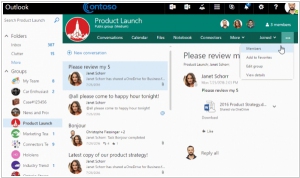
From now on, Office 365 users have the ability to involve external individuals in their projects, as Microsoft introduces guest access in Outlook on the web. Once added, guests receive a welcome email, granting them access to group files in SharePoint Online. They can also start receiving email messages and calendar invitations sent to the group, while being able to access the group through Office on the web and the Outlook Groups mobile application. Additionally, guests automatically gain access to cloud-based file attachments. While all guests need to sign in to Microsoft to obtain Office 365 access, they can belong to any email domain, regardless of it being affiliated with a business or not.
2016. Office 365 hets online booking app
Microsoft has expanded its Office 365 suite by introducing a new service called Bookings. This service enables customers to conveniently schedule appointments with businesses using online software, eliminating the need for phone calls. Bookings offers comprehensive appointment management capabilities, including sending confirmations and reminders, handling rescheduling and cancellations, and updating the business staff's calendar. Businesses are provided with a unique web page that is compatible with both desktop and mobile devices. Customers can easily select their preferred dates and times based on current availability, provide their contact information, and book appointments. The system then automates the remaining tasks associated with appointment management.
2016. Office 365 groups gets connectors
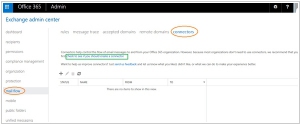
Microsoft has introduced Office 365 Connectors, which empower teams within an Office 365 Group to seamlessly share third-party services using a single sign-in or account. With Office 365 Connectors, teams can access and view information from various services like Twitter, LinkedIn, or Trello, directly through the shared Groups inbox. This integration consolidates email conversations, file storage, and calendar event management, providing teams with a cohesive experience to collaborate on group activities. The Connectors facilitate an integrated environment where teams can concentrate on their collective tasks and responsibilities.
2015. Microsoft released Office 2016
Microsoft is introducing Office 2016, presenting updated versions of Word, Excel, PowerPoint, and other applications. Users familiar with the 2013 edition of Microsoft's productivity software will find the look and feel to be reminiscent. The notable improvements in the 2016 edition primarily revolve around enhanced integration of collaboration tools. One significant addition is the co-authoring feature, enabling multiple users to collaboratively edit the same document in real time—an ability previously seen in Office's web-based counterparts and applications developed by Microsoft's competitors like Google. Furthermore, Office apps will now include the integrated chat service, Skype, allowing users to engage in instant messaging, share work images, or conduct video chats directly within a document. Additional new features include a search tool to facilitate the discovery of specific functions within Office and a research tool that extracts data from the internet and incorporates it into documents. Microsoft's approach emphasizes the promotion of the software suite through Office 365, the company's subscription program, rather than the traditional model of a one-time purchase granting perpetual software rights to the user.
2015. Microsoft opens Office for Android tablets to all
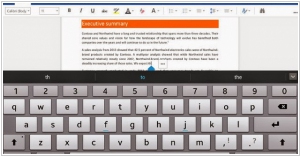
Microsoft introduced the preview version of the mobile Office for Android in November of the previous year. Now, the preview has been made accessible to everyone, allowing direct availability of Word, Excel, and PowerPoint through the Google Play Store (available). However, there are a few requirements to consider: You must possess an ARM-powered tablet with a screen size ranging from 7 to 10.1 inches, running on Android KitKat or Lollipop. Most contemporary tablets meet these criteria, enabling users to explore Microsoft's touch-optimized productivity suite.
2014. Microsoft adds Video service to Office 365
Microsoft has introduced a new feature called Office 365 Video, which allows users to post, share, and explore video content within their organization. It can be likened to a YouTube platform tailored for enterprise use. This feature serves various purposes, including video sharing for customer service, facilitating inter-team collaboration, and enhancing sales and training efforts. Office 365 Video will be available to all users without any additional cost where Office 365 is already deployed. Powered by Azure Media Services, it incorporates adaptive smooth streaming technology to optimize video playback based on the viewing device. This functionality will be made accessible to most enterprise Office 365 plans starting early next year.
2014. Microsoft makes Office free for iPhone, iPad and Android
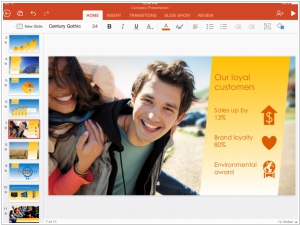
Microsoft has made its full-fledged Office apps freely accessible on iOS and Android platforms. This update introduces standalone Word, Excel, and PowerPoint apps specifically designed for iPhones. Previously, users could only access a single Microsoft Office app, which provided limited functionality for viewing and making basic edits to Word, Excel, and PowerPoint files on iPhones. However, with the new iPhone apps, users can now enjoy advanced editing features similar to those available on iPads, optimized to suit the smaller screens of iPhones. Additionally, Microsoft has announced the forthcoming launch of Office apps for Android tablets, which are currently under development and expected to be released in 2015. This update significantly expands the capabilities of the apps for free users, enabling them to create and edit documents in Word, Excel, and PowerPoint without requiring an Office 365 subscription. Previously, users had to pay $99 per year to access the ability to create or edit files.
2014. Dropbox integrates with Microsoft Office
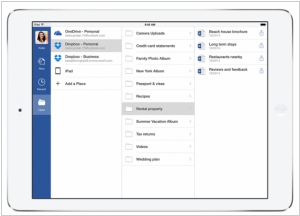
Microsoft and Dropbox have joined forces in a partnership aimed at enhancing the integration and support between Dropbox and Microsoft's Office suite. This collaboration encompasses four key elements: seamless editing of Office documents directly from the Dropbox mobile app, convenient access to Dropbox files from within Office apps, effortless sharing of Dropbox links from Office apps, and the development of official Dropbox apps for Microsoft's mobile offerings. Now, users have the ability to link their Dropbox account with Microsoft Word, Excel, or PowerPoint mobile apps, enabling them to browse folders and files stored on Dropbox and seamlessly view and edit them using the native Office apps. In exchange, Dropbox will actively promote Microsoft Office applications as the preferred choice for document creation and editing. It's worth noting that Microsoft has also established a separate partnership with Box, focusing on facilitating the coexistence of Office 365 and Box cloud storage and file synchronization software.
2014. Office 365 gets unlimited OneDrive storage.
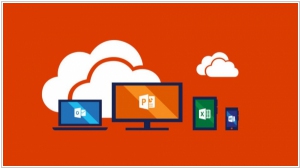
Starting today, customers of Office 365 Home, Personal, and University subscriptions will enjoy an increased storage capacity. Business customers will also receive unlimited storage in the near future, but for now, they have access to 1 TB of storage per user. With OneDrive, you can conveniently access your content across all your devices, collaborate on documents, and easily share files. While Google Drive, Box, Dropbox, and other cloud storage services have limitations on their storage capacities, OneDrive offers a significant advantage. If you reach the storage limit on those platforms, you have to purchase additional storage. Bitcasa, which was one of the few providers offering unlimited storage, recently discontinued that feature, giving Microsoft a substantial edge in terms of storage capabilities.
2014. How artificial intelligence in Office 365 works?
Back in the spring of this year, Microsoft embarked on a journey to incorporate artificial intelligence into Office 365. This endeavor, codenamed Oslo, aimed to automatically organize information for employees based on their interactions with colleagues and documents. Today, Microsoft unveiled the key components of this artificial intelligence and made them accessible to subscribers of the Enterprise version. These components include the Office Graph, a virtual network that leverages the connections between individuals and documents, and Office Delve, an intelligent search engine that identifies and presents relevant information in its appropriate context. For instance, when you view an event on your calendar, it will display the people involved in that event, as well as the associated documents, emails, and social posts.
2014. Microsoft lowers Office 365 pricing for small business
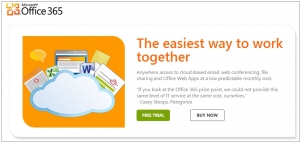
On October 1, 2014, Microsoft is set to unveil three new Office 365 plans designed specifically to cater to the requirements of small and midsized businesses. These plans include Office 365 Business Essentials priced at $5/user/month, Office 365 Business priced at $8.25/user/month, and Office 365 Business Premium priced at $12.5/user/month. Eventually, this new lineup will replace the existing plans for SMBs, namely Small Business, Small Business Premium, and Midsize Business. The most economical option offers cloud-based office products without desktop versions of Office. The middle-tier plan provides full Office applications across all devices, including PCs, Macs, iPads, and smartphones, along with 1TB of cloud storage. The Premium version offers enhanced features and additional services such as Yammer and Active Directory support. Moreover, Microsoft is increasing the maximum number of employees from 25 to 300, allowing more businesses to benefit from these offerings.
2014. Microsoft adds Office to Google's store, launches 7$/month version
It appears that the new leader of Microsoft, Satya Nadella, doesn't harbor the same inherent dislike for Google as his predecessor did. An example of this is the availability of Microsoft's Office Online in the Chrome Web Store. Not too long ago, Microsoft discouraged users from using Google Chrome due to concerns about data being taken for advertising purposes (you can watch the video above). By the way, there are rumors suggesting that the "Don't get Scroggled" anti-Google advertising campaign has been discontinued. In other news, Microsoft has introduced a personal subscription plan for Office 365 at a cost of $7 per month or $70 per year. This plan allows for the installation of the complete Microsoft Office suite on one computer, installation of the full mobile Office on one tablet, and unlimited usage of Office on smartphones and in web browsers. Previously, the cheapest option for Office 365 was $100 per year for up to 5 users or computers.
2014. Microsoft launches Office for iPad. Makes Office for iPhone and Android free
Looks like there are changes happening in Microsoft following the arrival of Satya Nadella. Previously, the Microsoft management believed that the use of Android and iOS devices was only a temporary situation and that eventually everyone would return to using Windows and be satisfied. However, the new boss stated today that "our customers are already using a number of computing platforms, leaving Microsoft with no choice." In light of this, he unveiled the highly anticipated Office for iPad. Unfortunately, if you want to use Word, Excel, and PowerPoint on an iPad, a subscription to Office 365 is required (starting at $6.99/month). The same applied to iPhone and Android devices before. However, today another remarkable development occurred: Office for iPhone and Android has become free. This means that you can now edit documents from the cloud storage service OneDrive on your smartphone at no cost. Perhaps the iPad version will also become free in the near future. It's worth noting that the current iPad version already offers a free option to view documents and present PowerPoint slides.
2014. Office 365 gets some social-intelligence features
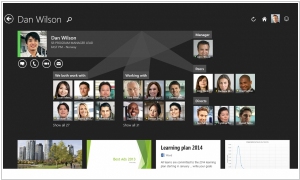
Microsoft today unveiled major update to its online office suite Office 365, adding some new social tools with a smell of artificial intelligence. First, the office is now watching you: with whom you communicate via email, chat and voice communications (via Lync), to whom you share documents. And basing on this data it creates for you "groups" (like in the picture above . Then these groups appear in Outlook and Yammer social network and you'll be able to intelligently filter mail and discussions by group/topic. Another intelligent page is now showing the documents that Artificial Intelligence Office considers most relevant to you #rightnow. So if you come to work sleepy and it's difficult for you to understand what you are doing here - open this page and everything will become clear. Here is this page: ***
2014. What is Office Online?
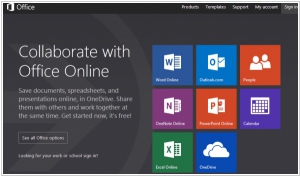
As you may be aware, Microsoft recently faced a situation where they were compelled to rename their file storage and synchronization service from SkyDrive to OneDrive. However, Microsoft's marketing team didn't stop there and decided to rename Office Web Apps as well. If you're unfamiliar with this title, it's not surprising. These applications (Word, Excel, PowerPoint, OneNote) operate within the SkyDrive (OneDrive) ecosystem, and you probably didn't pay much attention to their specific names. However, Microsoft is now introducing a new designation, Office Online, on a separate website. According to Microsoft's marketers, in the past, when people searched for "Office Online," they didn't understand why they needed to sign up for SkyDrive. With the introduction of Office Online as a distinct entity, users will now find it more easily and quickly start working. However, while this clears up one confusion, it gives rise to another: users now need to grasp the distinction between Office Online and Office 365.
2013. Web Office Apps add normal real-time co-authoring
Microsoft's online document editors, Office Web Apps, available in SkyDrive and Office 365, have offered collaborative editing for some time. However, the process used to be more traditional: users had to manually save their changes for collaborators to see them. Now, this feature is getting a modern upgrade. You'll be able to see who is currently working on a document and track their actions in real-time. Additionally, the need to save changes manually is eliminated as the document is now saved automatically, similar to Google Docs' functionality. However, it's important to note that Microsoft's online editors are not lagging behind Google's. In fact, with the latest update, Office Web Apps have made significant improvements in document formatting. For instance, the Word Web App now supports page headers and footers, find and replace functionality, table styles, and formatting. Similarly, the Excel Web App has introduced a status bar, drag and drop functionality for cells, and the ability to reorder sheets.
2013. Microsoft launched Office for Android
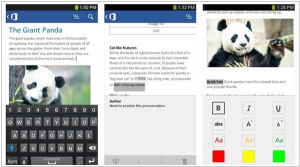
And you can easily download and install it for FREE on your phone, but there's one condition to keep in mind. What's that condition, you ask? Well, you must have a paid Office 365 subscription, which starts at $100 per year. This situation is reminiscent of the story behind the availability of Office for iPhone and Outlook for iPhone. If you're not keen on paying for Office 365, Microsoft suggests opting for a Windows Phone instead, where Office is genuinely accessible at no cost. This marks the new policy set by Microsoft. However, matters become even more complicated when it comes to tablets. The new mobile Office is not compatible with either iPads or Android tablets. This limitation stems from Microsoft's struggle to promote its own Surface tablets. As for the Office for Android app itself, it serves as a reliable tool for editing Word documents, Excel spreadsheets, and PowerPoint presentations. It operates smoothly on Android 4.0 and later versions, with SkyDrive serving as the default storage location for documents.
2013. Office 365 adds Business Intelligence tools

While Apple makes its first steps with online office suites and learns how to draw simple diagrams, Microsoft has built business intelligence tools - Power BI - into its Office 365. This is quite useful thing, and not only for big companies but also for small business. It allows you to sort, group and organize large datasets, visualize them and create beautiful reports that will be updated when the data source is updated (data source is an Excel table). For example, you have a large table of orders loaded from your accounting system. With Power BI you can turn this large and unclear table into small and useful tables, for example: customers by industry, customers by city, sales by month, top customers by profit, etc. These little pieces of information will help you to understand who is your target audience and where your business is heading. ***
2013. Microsoft released free Office for iPhone
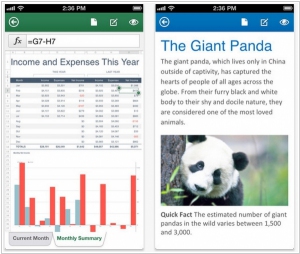
Think Microsoft has finally stopped playing political games and released Office for the competing platform? Of course not. Political games go on. Just Microsoft has invented the better idea. Yes, they are really launching full-featured Word, Excel and PowerPoint for iPhone. And these apps - are really free. But they can be used only by Office 365 subscribers (who pay from $99.99 a year). And, of course, these apps can open and edit only those documents that are stored in SkyDrive cloud or on enterprise SharePoint server. But even with these limitations, Microsoft hasn't yet dared to release Office for iPad, otherwise its latest ads iPad vs Surface wouldn't be so funny any more. ***
2013. Building a company website: Microsoft Office 365 vs SharePoint
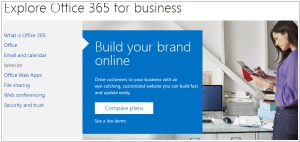
Perhaps it may come as a surprise to many, but Microsoft Office 365 offers the ability to create a public website for your company using SharePoint Online. Building websites on SharePoint has been a long-standing practice. However, it used to be quite expensive due to the cost of SharePoint licenses and Windows hosting. Additionally, SharePoint was originally designed for intranet portals and was not ideally suited for public sites. As a result, only large companies would use SharePoint as their website engine for various reasons. Fortunately, with the introduction of Office 365, things have changed for the better. Small business owners with an Office 365 subscription can now create a company website for free. The only technical skill required is Word editing.
2013. Real-time co-authoring in PowerPoint Online. Office Web Apps on Android tablets
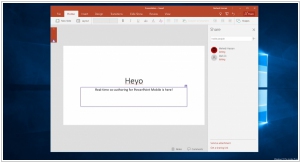
Last week, a Microsoft representative made the following statement: "When we introduced the Office Web Apps in 2010, they were designed as companions to the Office desktop experience, enabling users to create and review content while on the go. Since then, we have made significant investments in Office Web Apps to enhance collaboration, document authoring, and accessibility across various devices. Our objective is to provide reliable Office Web Apps that empower users to create professional documents entirely online. Furthermore, in the next decade, we plan to phase out desktop Office sales and transition all users to the online version." Alongside this announcement, two new features were introduced: real-time collaborative editing in PowerPoint Online (see the video above) and support for the Chrome browser on Android tablets.
2013. Office 365 for Business: new pricing quest from Microsoft

Following the recent launch of Office 365 home version, Microsoft is now introducing an updated version of Office 365 for Business. Similar to its predecessor, the business edition not only includes the familiar office editors (Word, Excel, PowerPoint, OneNote, Access, InfoPath) but also incorporates essential components such as the Exchange email server, SharePoint portal, and the Lync communication system. Additionally, it offers various IT-friendly features like Active Directory integration and the Admin Console. However, Microsoft's subscription plans for Office 365 for Business can be quite bewildering. Some editions exclude desktop Office applications, while others include them. Certain plans allow installation on up to five computers, whereas others only permit installation on a single device. Prices can be structured as monthly or yearly payments, and each edition imposes different user limits. For instance, Office 365 Small Business Premium, which offers functionality comparable to Google Apps, is priced at $150 per user per year (in contrast to Google Apps, which costs $50).
2013. New Office 2013: Bring Your Own Office?
One of our Enterprise 2.0 2013 predictions was the further development of BYO (Bring Your Own) trend. We said that with the own devices, employees will bring to work their own apps. Today, after the official release of Microsoft Office 2013, it looks like our prediction is coming true. Just look at the video: some guy is showing how he works everywhere with his own office. It's definitely his OWN office (Home Premium), because the enterprise version of Office 2013 will appear only in a month. But what is the reason of this phenomenon? ***
2012. Microsoft Project and SharePoint will join Office 365
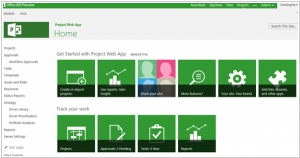
Together with SharePoint 2013 (probably in early 2013) Microsoft will release its project management system Microsoft Project 2013. These two systems have become inseparable, because SharePoint is used as a collaboration layer under the administrative component of MS Project. With the new version, this integration will become even tighter. You'll be able to start a new project by creating a simple page with a task list and calendar in SharePoint, and only when you need more close control over the project you'll be able to turn on this project management in the MS Project. But of course, the main news about Project 2013 is appearance of the online version Project Online, that will be available in the Office 365 cloud. And, (like in case with new SharePoint Online), developers will be able to create their own add-ons and even sell them via Office marketplace. ***
2012. 200,000 Toyota Employees Will Use Office 365
While Microsoft primarily positions Office 365 as a solution for small businesses, it has also become a necessity for large companies seeking Software-as-a-Service (SaaS) offerings. After Google secured a deal with General Motors to implement Google Apps, Microsoft needed a similar triumph. They achieved it by partnering with Toyota, which will provide Office 365 to its 200,000 employees based in Japan and other international affiliates. These employees will have access not only to online document editors but also to the web-based versions of Outlook/Exchange, Lync, and SharePoint. The exact cost per license for Toyota is undisclosed. Recently, Microsoft introduced the pricing for the new Office version, and it does not include options specifically designed for large enterprises. Office 365 Small Business Premium is priced at $150 per user per year, covering up to five user devices. The overall pricing structure for the new Office suite may be intricate, as is typical for Microsoft, but one thing is clear: Microsoft has made the Office 365 subscription model more cost-effective compared to purchasing traditional desktop licenses. This shift allows them to collect steady fees for the SaaS version rather than constantly convincing users to upgrade.
2012. Microsoft Office gets own (cloud) App Store
In today's digital landscape, it has become essential for popular services and applications to have their own dedicated App Stores. This is driven by the demand from third-party developers who wish to create add-ons for these popular products, while users eagerly seek to purchase and utilize these add-ons. Following this trend, Microsoft Office has also introduced its own App Store called the Office Store. It is specifically designed to work with Office 2013, providing users with an additional incentive to upgrade. The Office Store offers various applications, such as a mapping tool displaying points in Excel or an Outlook app that showcases LinkedIn profiles for contacts. Notably, the Office Store exclusively features cloud-based applications, excluding Visual Basic macros. One advantage of this approach is the elimination of the need to install additional apps. Microsoft allows developers to select their preferred cloud platform for hosting the application, whether it be Azure, Amazon, or another platform of their choice. In terms of revenue sharing, the Office Store offers a more favorable split compared to other app models, with developers receiving 80% of the revenue.
2012. Microsoft Office 365 with Dell: nobody works in the office any more
It appears that Microsoft might soon find it necessary to rebrand its Office 365 as something more fitting, perhaps like OnTheGo 365, as the current name is becoming less relevant. Based on Dell's video, which introduces Dell as an Office 365 provider, people nowadays are working in various locations such as streets, cafes, homes, cars, airports, and airplanes. They only come to the office for meetings, indicating a shift towards a more mobile and flexible work environment.
2012. New Office Web Apps add mobile touch interface, real-time collaboration
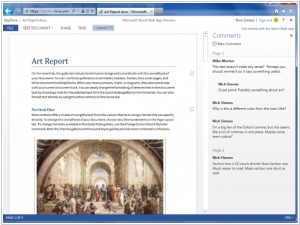
Microsoft started preview testing of the new version of its browser-based document editing applications Office Web Apps. Everybody can already join the preview on the SkyDrive or Office 365. The first thing that has changed - is the interface. It's now exactly like the upcoming Office 2013. And the main feature of this interface - is its adaption to the tablets with touch-screen. In general, the main objective pursued by Microsoft in this update - is to improve the performance of Office Web Apps on mobile devices (in mobile browsers). And the new mobile web interface for smartphones, is perhaps even better than its main competitor - Google Docs: ***
2012. New MS Office 2013: touch-interface, cloud roaming and subscription plans
As usual together with the new version of Windows 8 Microsoft will released the new Microsoft Office, because Windows can't live without the Office. Yesterday Steve Ballmer for the first time demonstrated Office 2013 to the public. As might be expected, the main upgrade is a new touch-interface, which is adapted for mouse, stylus and fingers. The second new feature - default integration with the cloud storage SkyDrive, which allows not only to save all files to the cloud, but also to sync files and Office settings between the all user computers and mobile devices. The third feature - integration between desktop Office and cloud Office 365. Microsoft will focus not on the Office sales, but on the Office 365 subscriptions, which also include desktop editors license. Of course, there are a lot of new small features that are probably not very interesting. More interesting is to pay attention to those features that will NOT appear in the Office 2013: ***
2011. Microsoft updates Office 365 and SkyDrive. Adds new territories
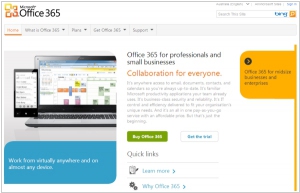
Microsoft has rolled out an update for its online collaboration suite, Office 365, introducing 30 new features. Among the noteworthy additions are support for Windows Phone 7.5, the ability to edit documents stored in SharePoint Online on Windows Phone, the availability of Lync client for both Windows Phone and Mac, integration of SharePoint Online with third-party applications through SharePoint Business Connectivity Services, and enhanced file uploading and sharing tools. Furthermore, Microsoft has expanded the availability of Office 365 to 22 new countries, including Argentina, South Africa, and Taiwan. In tandem with Office 365, its free mass-market alternative, SkyDrive, has also received updates. The updated SkyDrive features a new HTML5 uploader and improved file sharing capabilities, as previously mentioned. To see a demonstration of these new features and file management tools, you can watch the accompanying video.
2011. Microsoft is working on Office for iPad
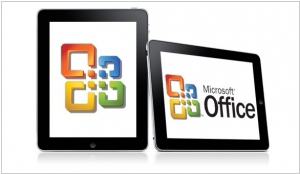
It seems, Microsoft is already feeling confidence in its mobile future. According to The Daily report, in the 1st half of 2012 Microsoft will release Mobile Office for the competing platform - iPad. Of course, iPad is very popular among business users and Microsoft can easily dramatically increase its incomes by selling mobile Word and Excel for the iPad at $10 (the planned price). But from the political point of view, Microsoft is not interested in making iPad even more attractive product, because it competes with the upcoming Windows 8 tablets. However, after the intention of HP and several other manufacturers to support Windows 8, Microsoft is not afraid of iPad any more. As expected, the MS Office for iPad will be significantly stripped-down compared to the desktop version and will be integrated with the online service Office 365. ***
2011. Video-battle: GMail vs Microsoft Office 365
Remember how Mark Benioff laughed at Microsoft's anti-advertising campaign? It turns out that Microsoft also can do similar things. A few days ago Google launched the advertising campaign that encourages users to switch from draconian email systems and their “embarrassingly outdated addresses” over to GMail, which features such niceties as free phone calls and video chat. For this campaign the video (see above) was created. You can see the red link to this video in your GMail-account. But Microsoft, whose Hotmail service is obviously one of the targets of Google's campaign, isn’t keeping quiet. Today another video hit the Web: ***
2011. Office Web Apps integrated into Russian Mail.Ru

Microsoft has come up with an intriguing strategy to promote its online office suite, Office Web Apps. They have integrated their online office applications into the popular Russian email service, Mail.Ru. Now, when Mail.Ru users receive attached documents, they can conveniently view them directly in their browser. However, editing capabilities are currently unavailable since Mail.Ru doesn't offer a document repository. It's worth noting that Mail.Ru is the first email service in the world, after Windows Live Hotmail, to integrate Office Web Apps. Interestingly, Microsoft chose to partner with Mail.Ru for this experiment in the Russian internet space, rather than collaborating with Yandex, the largest Russian search engine, which would seemingly have more reasons to support Microsoft in its battle against Google. This decision might be attributed to the fact that Yandex-Mail already has its own document viewer. However, unlike Microsoft's solution, Yandex's viewer compromises document formatting and lacks the ability to search within a document.
2011. Office 365 is going to expand: BlackBerry, Dynamics, Project, Visio

For now the SaaS suite Microsoft Office 365 includes e-mail server Exchange Online, portal Sharepoint Online, document editors Office Web Apps and communication server Lync Online. But Microsoft has plans to expand this suite and make it the one-stop-service for small and medium business. The BlackBerry Office 365 module has been already announced. It will provide Blackberry users the push-access to Office 365 data. Also, we have previously reported about the plans to add MS Dynamics CRM Online and the future MS Dynamics ERP to Office 365. And according to the latest (insider) information in late 2012 or early 2013 the suite will be expanded by the online version of project management solution MS Project and the diagram editor MS Visio. ***
2011. Office 365 is officially available in 40 countries

Today Steve Ballmer at the press-event in New York officially announced the launch of the cloud solution Office 365. And it's nice that it becomes available globally. Office 365 is offered in 21 languages (English, Br Portuguese, Chinese (simplified, traditional), Czech, Danish, Dutch, Finnish, French, German, Greek, Hungarian, Italian, Japanese, Korean, Norwegian, Polish, Spanish, Swedish, Romanian, and Russian) and 40 countries (US, Australia, Austria, Belgium, Canada, Colombia, Costa Rica, Cyprus, Czech Republic, Denmark, Finland, France, Germany, Greece, Hong Kong SAR, Hungary, India, Ireland, Israel, Italy, Japan, Korea, Luxembourg, Malaysia, Mexico, Netherlands, New Zealand, Norway, Peru, Poland, Portugal, Puerto Rico, Romania, Russia, Singapore, Spain, Sweden, Switzerland, Trinidad and Tobago, and the UK). ***
2011. Google and Box.net prepare to meet Office 365
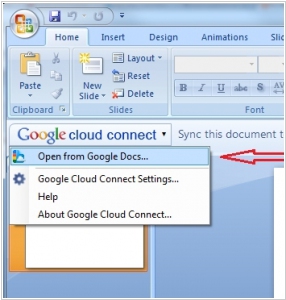
Next week Microsoft will officially launch its online office suite Office 365, and of course, the major competitors, Google and Box.net, want to spoil this party. First, they have integrated their solutions. Now Box.net users can edit any stored document in the Google Docs online editors. In addition, they can (in just one click) create new documents in Box.net folders by opening Google Docs apps. Recall that Box.net also features the similar integration with Zoho Docs, so now users will have a choice. Box.net CEO, Aaron Levy, says that he played with the beta version of Office 365 and that it’s lacking the power and functionality of the bunch Box + Google Docs. ***
2011. Windows SkyDrive moves from Silverlight to HTML5
Microsoft has finally killed the intrigue on the future of Silverlight in web-applications (recall this intrigue emerged at the end of last year). The new version of the online file storage Windows SkyDrive (which works as the basis of all Windows Live services) is completely rebuilt on HTML5 instead of Silverlight (even video player is now working on HTML5). SkyDrive is now much faster and supports all browsers (even Google Chrome). Along with the underlying technology shift, the developers have rebuild the service interface - it's now very similar to the Windows folder interface. Moreover, users of Windows 7 and Internet Explorer 9 can get to SkyDrive directly from the taskbar and with one click create Word, Excel, PowerPoint documents in Office Web Apps online editors: ***
2011. Office 365 vs Google Apps: first look
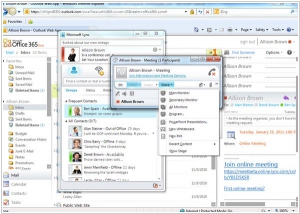
Microsoft has opened its online Office 365 for public beta testing and there are already first reviews, so we can already judge of how this service will justify its label "Google Apps killer". Recall, Office 365 includes online versions of Exchange, Sharepoint, Lync and the office suite Office Web Apps. So the functionality of Office 365 is even better than in Google Apps. But "killing Google Apps" hardly possible because these are quite different products. Office 365 is more appropriate for medium and large companies, who used to work in Microsoft-oriented IT infrastructure, that already have an IT administrator who knows Active Directory, Exchange and Sharepoint settings. Without such administrator you can't manage Office 365, it's not so simple as Google Apps. ***
2010. 5 Enterprise 2.0 forecasts for 2011

It's not very interesting to read IT analysts' forecasts for the next year. All of them are predicting further growth of cloud IT infrastructures, the increasing number of mobile apps, SaaS-service, further implementation of social tools into all business applications, further integration of the intranet systems with external social networks. Thank you, Captain Obvious. Unlike them, we'll focus on less global, but more interesting events that are expected to tale place next year: ***
2010. Microsoft Office 365 = Microsoft Exchange + Office Web Apps
Today, Microsoft has introduced a new service called Office 365, which serves as a rebranding of the SaaS package BPOS. The decision to change the name was anticipated, as critics of Microsoft often referred to BPOS as "Big Piece of Shit" rather than "Business Productivity Online Services". However, the modifications go beyond just the name. In addition to SaaS versions of Exchange Online, Sharepoint Online, and Lync Online, the new service will also include the online office tools known as Office Web Apps. This means that Office 365 can now be seen as a comprehensive alternative to Google Apps. The service will be offered in two editions. The Small Business Edition, priced at $6/user/month, is designed for companies with fewer than 25 users and offers basic functionality. On the other hand, the Enterprise edition provides enhanced customization and administration features, complete functionality, and grants users access to the desktop suite Office Professional Plus with pay-as-you-go licensing. The pricing for this edition ranges from $2 to $27/user/month, depending on the chosen configuration. It's worth mentioning that Microsoft intends to incorporate its CRM and ERP into the SaaS suite as well. Currently, Office 365 is in the beta stage and is set to be available worldwide next year.
2010. MS Office Web Apps go global, add embed-features
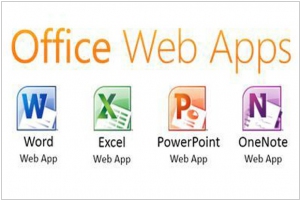
Today, Microsoft has released the second update for its online office suite Office Web Apps and has expanded its availability to seven additional countries, including Australia, Austria, Belgium, France, Germany, Russia, and Switzerland. The initial update in August introduced some highly useful features, such as charts and auto-fill in Excel Web App, as well as a free clip-art gallery in PowerPoint Web App. Today's update is equally exciting, as it now allows users to embed PowerPoint presentations, Excel charts, and tables into any website or blog. When inserting an Excel table, visitors can modify cell values to recalculate results, while the original Excel file in your account remains unchanged. Conversely, any changes made to the original Excel file will automatically update the table or chart in the embedded widget, ensuring that visitors always have access to the latest information. According to Microsoft, within the first 100 days of its release, Office Web Apps were utilized by over 20 million people.
2010. Windows Live Office and Office Web Apps are available for all
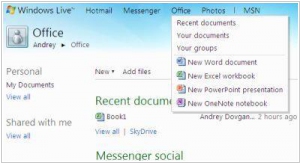
Yesterday, Microsoft officially launched Windows Live Office with Office Web Apps for english-speaking users (US, UK, Canada & Ireland). But anyone can already use them by switching the language in the Live ID account to English. Documents can be accessed in Office menu or SkyDrive menu. To understand why, read our review. Unfortunately, the first impression of Windows Live Office - is negative. Of course, we knew that online office apps will be light. And the fact that there are no diagrams and no cell autofill in the Excel Web App, and no rich paste in OneNote Web App, and no file move between folders in Live Office - all these is not disappointing. But the main thing that we expected - correct Word formatting support - actually doesn't work. ***
2010. What will Microsoft's online office look like?
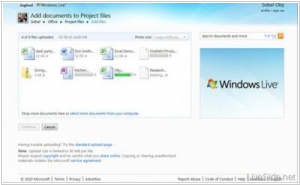
Microsoft has done a great job to confuse users with their online office applications. Office Live, Office Live Workspace, Office Live Small Business, Live Folders, Foldershare, Live Docs, SkyDrive, Live Mesh, Docs.com, Office Web Apps - a lot of similar in functionality or name services, formed in result of numerous acquisitions and rebrandings. Taking into account the existence of Exchange and Sharepoint SaaS versions (BPOS), it becomes a mystery - what Microsoft's online office suite is and what it's target audience. The new version of Windows Live Wave 4 (which includes the online office) is trying to bring this chaos into order, however, again by the numerous mergers and renamings. Let's try to understand all this stuff. ***
2010. MS Office 2010 released. Time to upgrade to Google Docs
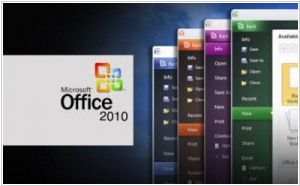
Today, Microsoft officially launched its Office 2010 for companies using the volume-licensing. For other companies and users the office suite will be available in June. The web-based version - Office Web Apps, that is the main new feature in Office 2010 and its main weapon in competition against Google Docs, will appear also in June. Google responded to the release in very original way - they used the fact that the main competitor to Office 2010 is actually not Google Docs, but Office 2007 (or 2003). The point is that why pay several hundred dollars for the new version of Office 2010 (+ Sharepoint 2010), if using Office 2007 in combination with Google Docs, you can get even more features at virtually no cost. Here is the comparison table, that was published in the Google Enterprise blog: ***
2010. Facebook + MS Office Web = Docs.com
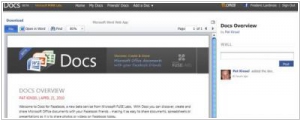
Today, Microsoft and Facebook opened the new service (+ Facebook app) Docs.com, which allows to store and display office documents on your Facebook profile and share them (for viewing and collaborative editing) with your friends, groups or all Facebook users. Documents can be viewed in the browser with the new viewer and edited with Office ***
2009. Microsoft starts free Web-based Office testing
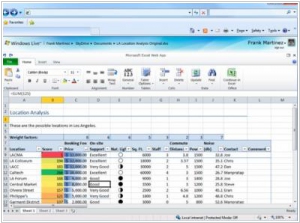
At last (after the July announcement) Microsoft is opening web-based Office 2010 applications to beta-testers. The web Office will have a long official title: Microsoft Office Web Applications. As we already informed, it will be available in two editions: Free and Business. The business version will work on top of SharePoint 2010 (behind the firewall). And free version will work on top of the online file storage service Windows Live SkyDrive (that provides 25Gb for free). Yesterday one thousand of SkyDrive happy users already got an access to online Word, Excel, PowerPoint and OneNote. And their reviews are quite different - from "awesome" to "tedious". Here are the most interesting points: ***
2009. Microsoft announced MS Office Web technical preview
Microsoft has made an announcement today regarding the Technical Preview of Office 2010. The upcoming release of Office 2010 will feature Office Web, which consists of lightweight web applications including Word, Excel, OneNote, and PowerPoint. Office Web will be accessible for free to users with a Microsoft Live account. Microsoft plans to provide two solutions for enterprises. One option involves hosting Office Web as part of Microsoft's Online Services, while the other option allows organizations to install the software on-premise, integrating it with SharePoint. The self-hosted version of the browser-based Office suite is expected to be highly appealing. Microsoft believes that this approach will differentiate its offering from competing suites like Google Apps, Zoho, and ThinkFree. Undoubtedly, this release will have a significant impact on both consumers and enterprises. The availability of a free browser-based Office application that seamlessly synchronizes with the desktop version and enables collaboration between users on both systems will be a noteworthy development.
2008. Web-based MS Office to work on Macs, iPhone
In a recent Microsoft blog post on Channel 10, it was reaffirmed that the web-based version of Office will not be limited to Windows or Internet Explorer. The upcoming Office Web Applications will be compatible with Firefox and Safari, enabling them to run on Linux and the iPhone. Microsoft's Sarah Perez, the blogger, also clarified that the use of Silverlight, Microsoft's alternative to Adobe's Flash, will not be mandatory. While Silverlight can enhance the user experience with sharper images and improved rendering, it is not a requirement. However, Microsoft has integrated Silverlight technology into the multi-file upload function of Office Live Workspace for an enhanced experience. Although Microsoft has not explicitly stated whether there will be a free version of the web-based Office apps, it is likely that both free and paid options will be available, as they will be part of Office Live, which offers both subscription and free versions. On the corporate side, Microsoft has announced that the Office Web Applications will be integrated with SharePoint.
2008. Microsoft Office Is Coming To the Cloud
During the Microsoft Developers Conference, Microsoft revealed that its Office suite, including Word, Excel, PowerPoint, and OneNote, will be available in the cloud as part of its Windows Azure platform. These browser-based versions of the applications will be compatible with Firefox, Internet Explorer, Safari, and Windows Mobile devices. Although the release date of the suite has not been disclosed, Microsoft stated that it will undergo a tech preview for developers later this year. The announcement comes as part of Microsoft's larger shift to the cloud with Azure, although it is seen as a somewhat delayed response to competitors in the productivity space, particularly Google. By introducing a web-based Office suite, Microsoft aims to retain its existing customers and prevent them from switching to alternative products. The company recognizes the need to adapt to the multi-device, web-centric world and find ways to monetize this shift. The web-desktop hybrid functionality of the new suite aligns with Microsoft's emphasis on the Windows Azure cloud platform. Although pricing details remain undisclosed, Microsoft mentioned that the suite will be a lightweight version of the client-based Office suite and will be offered as a bundled package rather than individual components.
2008. Microsoft’s Answer To Google Docs Hits 1 Million Users
Microsoft has announced a significant milestone for its Office Live Workspace Beta, reaching one million users. Serving as an extension to Office and a rival to Google Docs and Zoho, the service was introduced last winter and made available in public beta in March. Initially, Live Workspace received criticism for its lackluster web-based text editor. However, instead of focusing on improving online document editing like its competitor Google Docs, Microsoft aims to strengthen its Office desktop suite with Live Workspace. Users are encouraged to edit their documents through Office products such as Word, with Live Workspace syncing changes to an online archive and other collaborators. While the site does offer an online editor, Microsoft does not prominently highlight it, strategically positioning Live Workspace as a supplementary feature for Office rather than a direct Google Docs competitor. This approach aligns with Microsoft's dominance in desktop publishing software and limited presence in web-based collaborative solutions, as it aims to maintain the perception that desktop software is necessary for document editing.

